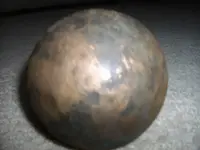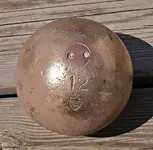You are using an out of date browser. It may not display this or other websites correctly.
You should upgrade or use an alternative browser.
You should upgrade or use an alternative browser.
cannonball ?
- Thread starter w.poort
- Start date
civil_war22
Relic Recovery Specialist
- Joined
- Dec 5, 2008
- Messages
- 3,215
- Reaction score
- 2,814
- Golden Thread
- 1
- Location
- NW Arkansas
- 🥇 Banner finds
- 1
- 🏆 Honorable Mentions:
- 1
- Detector(s) used
- Fisher F75 SE/LTD2, minelab Etrac, whites classic id, spectrum xlt, fisher f7, fisher 1266, king of all Tesoro Cibola, Tesoro Vaquero, Fisher 1280-X, minelab equinox, Fisher F75+ Garrett AT MAX
- Primary Interest:
- Relic Hunting
I found a article earlier on bronze cannonballs. It said the 9 pounders were about 5 to 5.5 inches in diameter and were from the mid to late 1700's
Upvote
0
vhs07
Bronze Member
- Joined
- Dec 24, 2007
- Messages
- 1,337
- Reaction score
- 2,212
- Golden Thread
- 0
- Location
- Victoria, Texas
- Detector(s) used
- Equinox 800, Nokta Impact, Tesoro Cortez
Upvote
0
You may want to see if a local bamb squad or medical person you have an in with can x-ray the item. Some cannonballs hade fuzes that in turn can still be live and working. They usually look similar to the shot put plug but should have writing on the plug. I've been very amazed how many times I've found VERY corroded items only to find out they were perfectly preserved and had movable parts on the inside. As a job I find old bombs and ordnance, we've came across many items from WW 1 that were in bogs or creeks that still had fully functioning fuzes.
On the good side, most cannonball fuzes used a type of pyrotechnic action to set it off, so it might be safe to keep. I just wouldn't be dropping it, hitting it, or placing it anywhere near a fireplace or oven.
Great find though!

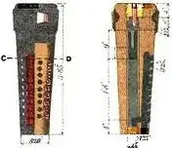
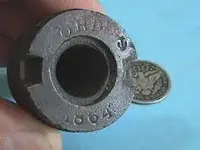
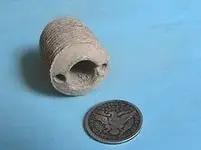
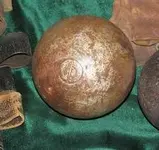
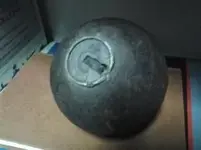
On the good side, most cannonball fuzes used a type of pyrotechnic action to set it off, so it might be safe to keep. I just wouldn't be dropping it, hitting it, or placing it anywhere near a fireplace or oven.
Great find though!






Last edited:
Upvote
0
taz42o
Bronze Member
TheCannonballGuy says, "there were absolutely no brass or bronze or copper cannonballs (nor Grapeshot-balls, nor Canister-balls) used in North America. "
Except texas.
http://www.treasurenet.com/forums/what/270902-mini-cannon-ball.html
Except texas.
http://www.treasurenet.com/forums/what/270902-mini-cannon-ball.html
Last edited:
Upvote
0
AlabamaRelic
Hero Member
- Joined
- Jul 2, 2009
- Messages
- 545
- Reaction score
- 571
- Golden Thread
- 0
- Location
- NW Alabama
- Detector(s) used
- Ace 250
Have you ever heard of the term "brass balls"?
Upvote
0
william333
Jr. Member
- Joined
- Nov 12, 2012
- Messages
- 21
- Reaction score
- 0
- Golden Thread
- 0
- Primary Interest:
- All Treasure Hunting
the french supplied the americans with bronze cannonballs during the revolution war.
Upvote
0
TheCannonballGuy
Gold Member
- Joined
- Feb 24, 2006
- Messages
- 6,606
- Reaction score
- 13,450
- Golden Thread
- 0
- Location
- Occupied CSA (Richmond VA)
- Detector(s) used
- White's 6000, Nautilus DMC-1, Minelab
- Primary Interest:
- Relic Hunting
(Note: I'm reposting my reply from a more-recent discussion thread, due to multiple posts of this ball by its finder, under different posting-names.)
Your questions about that bronze ball have already been answered in replies to your many previous posts of it. But since you are unsatisfied with those answers, I'll give you mine. I do not mean any of the following info as bragging -- my intention is only to give you a "Credibility Rating" for my answer to your questions. My professional credentials for answering:
I've been a nationally-known dealer of historical cannonballs for nearly 40 years.
I'm a multi-published Historian author of books and magazine articles about cannonballs.
I'm a paid Consultant to various museums (including the US National Park Service) about Historical artillery projectiles.
There are several characteristics which absolutely disqualify a metal ball from being a real cannonball. Some of the disqualifying characterstics are:
1- being an incorrect shape (such as out-of-round, even a bit egg-shaped)
2- being an incorrect metal
3- being an incorrect size (diameter)
4- being an incorrect weight
5- the presence of markings such as letters or numbers
6- the presence of flat-spots or a raised band
7- having too many "fuzeholes" in it.
Your bronze (or perhaps actually brass) ball is disqualified from being a real cannonball by reasons #1 and #2. There's no need to go any further down the list. Your photo shows it is somewhat egg-shaped. (Even excluding the shadow around that ball's lower left edge.) EVERY real cannonball was very carefully manufactured -- and inspected afterward -- to be perfectly round. (That's known as a "True Sphere.") The reason is that if a cannonball was even a little bit out-of-round, it could jam in the cannon's barrel during loading or firing, thereby causing the cannon itself to explode. That's why an Artillery Ordnance Inspector very carefully checked EVERY cannonball to make certain it was perfectly-round.
Disqualifying reason #2 is that you said (in a previous post) that your bronze ball was found in a Michigan lake. As you've already been told, it is a well-documented Historical fact that no bronze, brass, or copper cannonballs were ever used in North America -- except for a few Mexican-made ones at a US-Mexican War (1847) battlesite in Texas near the border with Mexico.
You asked what your bronze ball actually is. My answer:
Iron is the cheapest of all metals. When a ball is made of a more-expensive metal than iron, the reason is, iron is considered "unsuitable" for the ball's intended purpose. For example, as you know, iron is subject to rapid rusting, and it also can cause sparks. Your ball is made of the more-costly metal bronze (or perhaps brass) in order to avoid corrosion or sparking during its intended use. It was most probably manufactured to be a "Crusher-ball," for pulverizing coal or some other flammable material ...or a material which is corrosive to iron, resulting in contamination of the material during the pulverizing.
There is one other possibility. Your ball may be an inaccurately-weighed Sports Shot Put ball. Some of those are made of bronze/brass ...like the one Vhs07 posted in reply to one of your posts.
Your questions about that bronze ball have already been answered in replies to your many previous posts of it. But since you are unsatisfied with those answers, I'll give you mine. I do not mean any of the following info as bragging -- my intention is only to give you a "Credibility Rating" for my answer to your questions. My professional credentials for answering:
I've been a nationally-known dealer of historical cannonballs for nearly 40 years.
I'm a multi-published Historian author of books and magazine articles about cannonballs.
I'm a paid Consultant to various museums (including the US National Park Service) about Historical artillery projectiles.
There are several characteristics which absolutely disqualify a metal ball from being a real cannonball. Some of the disqualifying characterstics are:
1- being an incorrect shape (such as out-of-round, even a bit egg-shaped)
2- being an incorrect metal
3- being an incorrect size (diameter)
4- being an incorrect weight
5- the presence of markings such as letters or numbers
6- the presence of flat-spots or a raised band
7- having too many "fuzeholes" in it.
Your bronze (or perhaps actually brass) ball is disqualified from being a real cannonball by reasons #1 and #2. There's no need to go any further down the list. Your photo shows it is somewhat egg-shaped. (Even excluding the shadow around that ball's lower left edge.) EVERY real cannonball was very carefully manufactured -- and inspected afterward -- to be perfectly round. (That's known as a "True Sphere.") The reason is that if a cannonball was even a little bit out-of-round, it could jam in the cannon's barrel during loading or firing, thereby causing the cannon itself to explode. That's why an Artillery Ordnance Inspector very carefully checked EVERY cannonball to make certain it was perfectly-round.
Disqualifying reason #2 is that you said (in a previous post) that your bronze ball was found in a Michigan lake. As you've already been told, it is a well-documented Historical fact that no bronze, brass, or copper cannonballs were ever used in North America -- except for a few Mexican-made ones at a US-Mexican War (1847) battlesite in Texas near the border with Mexico.
You asked what your bronze ball actually is. My answer:
Iron is the cheapest of all metals. When a ball is made of a more-expensive metal than iron, the reason is, iron is considered "unsuitable" for the ball's intended purpose. For example, as you know, iron is subject to rapid rusting, and it also can cause sparks. Your ball is made of the more-costly metal bronze (or perhaps brass) in order to avoid corrosion or sparking during its intended use. It was most probably manufactured to be a "Crusher-ball," for pulverizing coal or some other flammable material ...or a material which is corrosive to iron, resulting in contamination of the material during the pulverizing.
There is one other possibility. Your ball may be an inaccurately-weighed Sports Shot Put ball. Some of those are made of bronze/brass ...like the one Vhs07 posted in reply to one of your posts.
Last edited:
Upvote
0
Similar threads
- Replies
- 4
- Views
- 349
Users who are viewing this thread
Total: 1 (members: 0, guests: 1)

